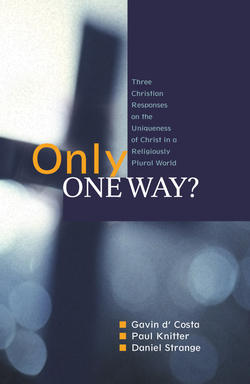Читать книгу Only One Way? - Gavin D'Costa - Страница 12
На сайте Литреса книга снята с продажи.
Biblical and early church background
ОглавлениеThree interesting attitudes to this religious pluralism are discernible within the first few centuries that continue to shape contemporary Catholicism. First, there was a clear emphasis on the necessity of faith in Christ for salvation, echoing John 14.6: ‘I am the way, and the truth, and the life. No one comes to the Father except through me.’ This faith had an ecclesial dimension, including the necessity for baptism into Christ’s body, so that membership of the Church (in the case of adults, always assuming active faith and love in the person’s heart) was required for salvation (Acts 2.23, 41; 8.12–13; 16.15, 31–3; Matt. 28.19; 2 Cor. 5.17; Gal. 6.15; 3.27; Rom. 6.3–4). This first emphasis meant that Christianity was a vigorous missionary religion with an explicit desire to convert all peoples. This was formulated in the famous axiom extra ecclesiam nulla salus teaching (no salvation outside the Church), which was formally taught at the Council of Florence in the fifteenth century, but originates from as early as the second century and was consolidated by Augustine of Hippo. It is formally still taught in the Roman Catholic Church. This missionary drive excluded no religion or culture, although Jewish rejection of the gospel was always an embarrassment in the early days and eventually led to a strong anti-Jewish polemic. This teaching presupposed that God created the world good and that the fall brought in death and alienation between humans and God (Gen. 3; Rom. 5.2–21; Luke 11.21–2; John 16.11). This breach initiated by Adam and Eve meant that the history of restoration of the broken covenant between God and humans begins in Israel and comes to completion in Christ. It is quite important to note that until the twentieth century there has generally been what might be called a salvation pessimism about the salvation of non-Christians, that is, there is an assumption that because of sin non-Christians will be lost. Our recent history can be characterized by a move to a salvation optimism, which is always in danger of playing down the power of sin and exalting the power of human goodness. Doctrinally, the latter, while being a wonderful reality, is biblically insufficient for salvation: men and women cannot save themselves by their own righteousness.
Second, various early Christian intellectuals had learnt greatly from Greek philosophy and could not help but wonder at the wisdom they had found there: truths that were consonant with revelation, moral exhortation of a high order, and indeed, philosophical frameworks that allowed for the sophisticated explication of Christian revelation and for its defence against philosophical attacks. They developed three crucial theories to explain pagan wisdom: the prisca theologia (ancient theology), the praeparatio evangelica (the preparation for the gospel), and the semina verbi (the seeds of the Word). The first held that all pagan wisdom was actually an explicit or implicit unacknowledged borrowing from the Old Testament – a theory of a form of intellectual plagiarism. The latter two theories, by contrast, argued that God provided knowledge in nature and in cultures that led people to the truth of the gospel, such that it was possible to know God and find truth, goodness, and beauty outside of Christianity although these truths always derived (causally, and sometimes historically) from the Christian revelation. These truths prepared the person for salvation through cultivating the good life but they were not in themselves saving revelation – which came through Christ. These truths found their fulfilment and culmination in Christian revelation.
Third, the early Christians were faced with the question of the righteous of Israel: were they lost because they were born before the time of Christ? This was unthinkable to many of them. The saints of Israel had valid faith in God, for they partook of the very covenant which is the root upon which the Church was grafted (Rom. 11.11–24). Ideas of the justice of God (in tandem with passages like Acts 2.7; Rom. 10.6–7; Eph. 4.8–9; 1 Pet. 3.18–20) led to the notion that these righteous awaited the coming of Christ, who as the creed has it, ‘descended into hell’, where he preached salvation to those who deserved it so that they might be saved. This scenario led to the idea of the limbus patrum (the limbo of the fathers) as a kind of holding tank for the righteous who died before Christ. In the third century Clement of Alexandria and others included righteous pagans in the limbus patrum, which suggested the possibility of salvation for all persons, not just Israelites. Augustine likewise insisted on an invisible Church from the time of Abel composed of the righteous. For all these thinkers, the assumption was that after Christ came, no one was in an analogous position to these righteous gentiles and holy pre-Christian Jews.
Together, these three attitudes run throughout Christian history, leading to three widely adopted theologoumena in the modern period which are central to Catholic teaching: (1) the necessity of Christ and his Church for salvation; (2) the justice of God towards the righteous before (and obviously after) the coming of Christ, but the application was related to those before Christ; (3) the possibility of goodness, truth, and beauty being present in pagan traditions, but never in a manner equal to Christ and his sacramental presence in his Church in kind or degree. However, the modern period introduces a new hermeneutical context which contextualizes this tradition: that well until the age of discovery in the fifteenth century it was generally assumed by most theologians that after the time of Christ everyone knew the gospel. If a person was not a Christian they had explicitly rejected the truth of God. This meant that Judaism and eventually Islam (from the seventh century on) were both seen as heretical and/or schismatic movements, rather than genuinely ‘other’ as we tend to view these and other traditions today.
